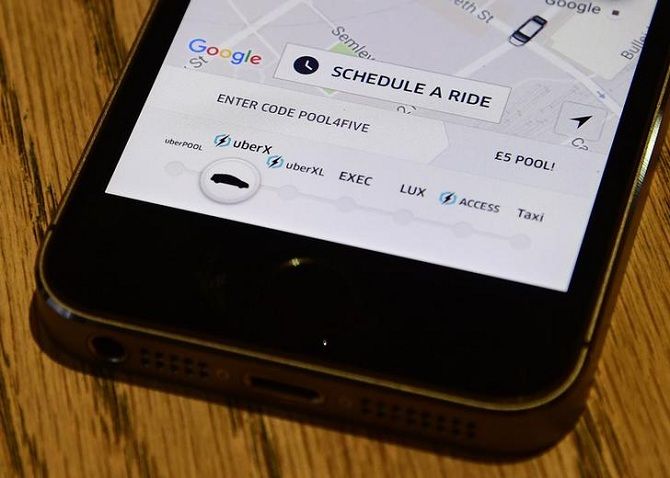Don't believe us? Then listen to the expert.
Harish Rao dispels myths about Ola and Uber's dynamic pricing model and explains why government interference in it will finally hurt us, the riders.

The demand-supply gap would never be discovered.
And customers in many areas would have no cabs available. Photograph: Toby Melville/Reuters
Cab aggregators such as Uber and Ola have been pushed into defending their pricing structure, following the government's announcement about the setting up of a committee to review the existing permit conditions for commercial vehicles.
'Surge pricing' is perceived as predatory in nature and against consumer interests.
This perception of dynamic pricing is derived from the general population's limited knowledge of the subject.
However, a deeper inspection can help dispel some myths surrounding this concept.
Actually, we need to understand what surge pricing is and how it works.
Even though the algorithms implemented by Uber and Ola are their individual proprietary knowledge, the basics are still defined by simple economic theories.
Surge pricing is a signalling mechanism that identifies a gap between demand and supply.
Let us assume that a specific region experiences a sudden increase in demand.
How does the aggregator get this information?
The demand signal is derived from the number of app openings by customers in this region.
Similarly, the supply signal is derived from the number of driver apps open in the region or its vicinity.
A demand signal that is higher than the supply signal signifies a surge in demand over the prevailing supply.
This gap between demand and supply can be rectified either by reducing the demand or by increasing the supply.
Demand is reduced by increasing the price of availing a cab (surge pricing).
Prospective customers are shown the surge pricing in multiples of normal pricing.
The higher the demand-supply gap, the higher the multiple.
The new price point automatically reduces the demand for the resource and achieves a new equilibrium.
How does the supply increase?
Just as prospective customers are shown the existing pricing condition, suppliers have a region-wise map of prevalent pricing.
Depending on the pricing levels, suppliers can opt to move their resources (cabs) to the region with higher pricing to service the demand and take advantage of it.
Thus, the price signal is critical in managing demand efficiently as well as reallocating supply.
In this context, prospective customers are not forced to use a particular cab aggregator.
Commuting needs are satisfied by multiple players such as other cab aggregators, taxi operators with flat pricing structures, buses and others.
The cab aggregator may lose customers to these different suppliers while opting for the right pricing strategy.
All app openings during the surge period don't translate into rides for cab aggregators.
If the price point is higher than the customer's expectations, then there are other options available for the customer, or the customer can decide to wait.
If more customers decide the same, then the demand for the cab aggregator's resources would dip, forcing the surge pricing level to plunge!
That is exactly the intended consequence of surge pricing.
What would happen if there is no surge pricing?
The demand-supply gap would never be discovered.
Referring to the example above, a few lucky customers in a specific region would avail of the cabs and the rest would have no cabs available.
A higher surge multiplier is an indicator of cab supply being far less than the demand for cabs.
The higher multiplier suppresses demand by forcing the customer to rethink as well as conveying the degree of mismatch to the cab drivers to direct them to reallocate their services to the affected region.
This leads to faster corrective action in the market, leading to quick drops in surge prices.
Hence, limiting this price (or the market clearing price) would suppress the true nature of the demand-supply gap.
A 5.0X conveys a higher mismatch in demand-supply than a 2.0X surge price.
It conveys the scarcity of the resource more definitively than the latter.
Capping surge pricing makes the markets respond more slowly to prevailing conditions and thus normalcy takes longer to be restored.
This is similar to models adopted in other sectors with supply constraints, such as aviation and hospitality.
Surge pricing by cab aggregators is perhaps the only model which helps tackle both demand and supply side issues, thereby facilitating a comprehensive solution. Even the Indian Railways is experimenting with dynamic pricing.
However, in these sectors new supply is not created; only demand is regulated by pricing.
Thus, a spike in fares would be limited only through competition, which is relatively lower in the airline and railways sectors.
Notably, the biggest gain from the disruptive entry of these cab aggregators has been the market determination of prices.
Arbitrary price controls by the government has burdened the industry with inefficiencies.
Stiff competition coupled with technological advances has allowed aggregators to bring in efficiencies with improved ride quality in response to consumer preferences.
The government can play an enabling role by easing supply restrictions such as artificial caps on permits and better public transport options.
The traditional arguments relating to limiting the number of cabs on the road for the purpose of maintaining quality and reducing congestion and pollution do not hold merit.
Rich economic literature suggests this, including a 2007 cross-country analysis by the Organisation for Economic Cooperation and Development. These restrictions have only incentivised private car ownership further and served to increase congestion and pollution levels.
Capping efficient dynamic pricing models, such as those used by aggregators, is regressive and would be detrimental to the public transport situation.
The only criteria should be clear disclosure of information to customers.
One can only hope that our policymakers put a cap on populist policies that appeal to passion over intellect, and in the process do great disservice to economic theory and growth.
Harish Rao is a professor at the International Management Institute, New Delhi.












 © 2025
© 2025